Scaphoid Bone
Table of Contents
Introduction
The scaphoid bone is a small, boat-shaped bone located in the human wrist. It is one of the eight carpal bones in the wrist and plays a crucial role in the function and stability of the wrist joint. The word “scaphoid” comes from the Greek word “skaphe,” meaning “boat,” which aptly describes the bone’s shape.
It is located on the thumb side of the wrist, near the base of the thumb. The scaphoid bone is approximately the size and shape of a cashew nut, with a concave surface on one side and a convex surface on the other.
Its main function is to provide stability and support to the wrist joint, allowing for smooth movement and flexibility. It also plays a crucial role in transmitting forces from the hand to the forearm.
The scaphoid bone is an important component of the wrist joint, providing stability and facilitating movement. Its susceptibility to fractures highlights the need for proper diagnosis and treatment to prevent long-term complications.
Anatomy of scaphoid
The scaphoid bone, also known as the navicular bone, is one of the carpal bones located in the wrist. It is situated on the thumb side of the wrist, near the base of the thumb. The scaphoid bone is roughly boat-shaped and has a concave surface on one side and a convex surface on the other.
The scaphoid bone consists of several anatomical features that contribute to its function and stability within the wrist joint. These features include:
- Proximal pole: This is the end of the bone closest to the forearm. It has a rounded shape and articulates with the radius bone, which is one of the two bones in the forearm.
- Distal pole: This is the end of the bone furthest from the forearm. It also has a rounded shape and forms part of the joint surface with other carpal bones.
- Waist: This is the narrowest part of the scaphoid bone, located between the proximal and distal poles. It is prone to fractures due to its relatively smaller cross-sectional area.
- Tubercle: This is a small bony prominence on the lateral (thumb) side of the scaphoid bone. It serves as an attachment site for ligaments that help stabilize the wrist joint.
- Articular surfaces: The scaphoid bone has articular surfaces on both sides. The proximal articular surface forms a joint with the radius bone, while the distal articular surface articulates with other carpal bones.
- Blood supply: The scaphoid bone has a unique blood supply pattern that makes it susceptible to complications if fractured. The blood supply enters through small branches at both ends of the bone, with limited blood flow to the central portion. This limited blood supply can hinder proper healing and lead to avascular necrosis if a fracture occurs.
The scaphoid bone plays a crucial role in the overall function of the wrist joint. It helps maintain stability and supports the movements of the hand and forearm. The bone transmits forces from the hand to the forearm, allowing for gripping, twisting, and other intricate movements.
Getting knowledge of the anatomy of the scaphoid bone is important in diagnosing and treating fractures or other injuries that may occur. Proper diagnosis and treatment can help prevent long-term complications and restore optimal function to the wrist joint.
Articulation of scaphoid
It articulates with several other bones, including the radius, trapezium, capitate, and lunate bones. The articulation of the scaphoid bone is important for wrist movement and stability.
The scaphoid bone articulates with the radius bone at the proximal end of the bone. This joint is called the radio scaphoid joint and allows for flexion and extension of the wrist. The scaphoid bone also articulates with the trapezium bone at the distal end of the bone. This joint is called the scaphotrapezial joint and allows for lateral movement of the wrist.
The scaphoid bone also articulates with the capitate bone at the distal end of the bone. This joint is called the scaphocapitate joint and allows for flexion and extension of the wrist. Additionally, the scaphoid bone articulates with the lunate bone at the proximal end of the bone. This joint is called the scapholunate joint and allows for rotation and lateral movement of the wrist.
The articulation of the scaphoid bone is important for wrist stability and function. Any injury or damage to the scaphoid bone or its articulations can result in pain, weakness, and limited range of motion in the wrist. It is important to seek medical attention if you experience any symptoms related to your wrist or scaphoid bone.
Functions of the scaphoid
One of the eight carpal bones in the wrist, the scaphoid bone is situated on the radial side of the wrist. It is shaped like a boat and plays an important role in the stability and movement of the wrist joint. Here are some of the functions of the scaphoid bone:
- Stabilization of the wrist joint: The scaphoid bone is an important stabilizer of the wrist joint. It helps to maintain the alignment of the bones in the wrist and prevents excessive movement of the joint. This is important for maintaining the strength and integrity of the wrist joint.
- Transmission of forces: The scaphoid bone helps to transmit forces from the hand to the forearm. When we grip or hold onto something, the forces generated by the muscles in the hand are transmitted through the scaphoid bone to the radius bone in the forearm. This allows us to perform tasks that require strength and dexterity.
- Articulation with other bones: The scaphoid bone articulates with several other bones in the wrist, including the radius, lunate, and capitate bones. This allows for smooth movement and coordination between these bones during wrist movements.
- Support for ligaments and tendons: The scaphoid bone provides support for several ligaments and tendons that attach to it. These include the dorsal and palmar radiocarpal ligaments, as well as the flexor carpi radialis and extensor carpi radialis longus tendons. These structures help to stabilize and move the wrist joint.
- Blood supply to the hand: The scaphoid bone is unique in that it has a tenuous blood supply. However, it plays an important role in supplying blood to the rest of the hand. This is because one of the main arteries that supply blood to the hand runs through a small channel in the scaphoid bone.
The scaphoid bone is an important bone in the wrist that plays a crucial role in stabilizing and moving the wrist joint, transmitting forces from the hand to the forearm, articulating with other bones in the wrist, supporting ligaments and tendons, and supplying blood to the hand.
Muscle attachment of scaphoid
The scaphoid bone does not have any direct muscle attachment. However, it is indirectly attached to various muscles of the wrist and hand through ligaments and tendons.
The dorsal and palmar radiocarpal ligaments attach to the scaphoid bone, which helps to stabilize the wrist joint. The dorsal radiocarpal ligament attaches to the dorsal surface of the scaphoid bone and extends to the radius bone. The palmar radiocarpal ligament attaches to the palmar surface of the scaphoid bone and extends to the radius bone.
The flexor carpi radialis tendon also attaches to the scaphoid bone. This tendon originates from the medial epicondyle of the humerus and runs through the carpal tunnel before attaching to the palmar surface of the scaphoid bone. The flexor carpi radialis muscle is responsible for the flexion of the wrist and abduction of the hand.
The extensor carpi radialis longus tendon also attaches to the scaphoid bone. This tendon originates from the lateral epicondyle of the humerus and runs along the dorsal surface of the wrist before attaching to the dorsal surface of the scaphoid bone. The extensor carpi radialis longus muscle is responsible for the extension of the wrist and abduction of the hand.
In summary, while the scaphoid bone does not have any direct muscle attachment, it is indirectly attached to various muscles of the wrist and hand through ligaments and tendons. These attachments help to stabilize the wrist joint and allow for movement of the wrist and hand.
Blood and lymph supply
The scaphoid bone has a unique blood supply that is important for its function and survival. The blood supply to the scaphoid bone comes from the distal and proximal branches of the radial artery, which run through a small channel in the bone called the scaphoid waist. The blood vessels that supply the scaphoid bone are small and can be easily damaged, which can lead to avascular necrosis (AVN) of the bone.
AVN occurs when the blood supply to a bone is disrupted, leading to bone death and eventual collapse. AVN of the scaphoid bone is a common injury that can occur due to trauma or repetitive stress. When AVN occurs, the bone tissue begins to die, which can cause pain, stiffness, and limited mobility of the wrist joint.
The lymphatic drainage of the scaphoid bone is also important for its function and health. The lymphatic vessels in the wrist drain into the axillary lymph nodes in the armpit. The lymphatic vessels help to remove waste products and excess fluid from the tissues surrounding the scaphoid bone, which helps to maintain its health and function.
The blood and lymph supply of the scaphoid bone is important for its function and survival. The blood supply comes from the radial artery, which runs through a small channel in the bone, while lymphatic drainage helps to remove waste products and excess fluid from the tissues surrounding the bone. Damage to the blood or lymphatic vessels can lead to AVN or other complications that can affect the health and function of the scaphoid bone.
Ligament attachment of scaphoid
The wrist joint has a tiny, boat-shaped bone called the scaphoid. It is a crucial bone for the stability and movement of the wrist. The scaphoid bone is connected to other bones in the wrist joint by several ligaments.
The scaphoid bone has several ligament attachments, including the radioscaphocapitate ligament, the scapholunate ligament, and the dorsal intercarpal ligament. These ligaments help to stabilize the scaphoid bone and prevent it from moving too much during wrist movement.
The radioscaphocapitate ligament connects the scaphoid bone to the radius bone and the capitate bone. This ligament helps to stabilize the scaphoid bone and prevent it from rotating or shifting too much during wrist movement.
The scapholunate ligament connects the scaphoid bone to the lunate bone. This ligament helps to stabilize the scaphoid bone and prevent it from moving too much during wrist movement. It is also important for maintaining proper alignment of the wrist joint.
The dorsal intercarpal ligament connects the scaphoid bone to the other bones in the wrist joint, including the capitate, triquetrum, and hamate bones. This ligament helps to stabilize the wrist joint and prevent excessive movement.
In conclusion, the scaphoid bone is connected to other bones in the wrist joint by several ligaments, including the radioscaphocapitate ligament, the scapholunate ligament, and the dorsal intercarpal ligament. These ligaments help to stabilize the scaphoid bone and prevent excessive movement during wrist movement, which is important for maintaining proper wrist function and preventing injury.
Conditions that affect scaphoid
There are several conditions that can affect the scaphoid bone, including fractures, avascular necrosis, and arthritis.
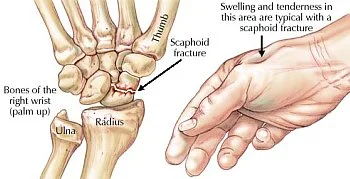
Scaphoid fractures are one of the most common injuries to the wrist. They typically occur as a result of a fall onto an outstretched hand, with the force of the impact being transmitted through the wrist joint and causing the scaphoid bone to break. Symptoms of a scaphoid fracture include pain, swelling, and tenderness in the wrist, as well as difficulty gripping or holding objects. Treatment for a scaphoid fracture typically involves immobilization of the wrist with a cast or splint, and in some cases, surgery may be necessary to repair the fracture.
Avascular necrosis is another condition that can affect the scaphoid bone. This occurs when there is a disruption to the blood supply to the bone, which can cause the bone tissue to die. Symptoms of avascular necrosis may include pain, stiffness, and limited range of motion in the wrist. Treatment for avascular necrosis may involve surgery to remove the damaged bone tissue and replace it with healthy tissue from elsewhere in the body.
Arthritis can also affect the scaphoid bone, particularly in cases of osteoarthritis or rheumatoid arthritis. In osteoarthritis, the cartilage that cushions the joints wears away over time, leading to pain, stiffness, and limited mobility. In rheumatoid arthritis, the immune system attacks the lining of the joints, causing inflammation and damage to the joint tissues. Treatment for arthritis may involve medications to manage pain and inflammation, as well as physical therapy to improve joint function and mobility. In some cases, surgery may be necessary to repair or replace damaged joint tissues.
Rehabilitation
Rehabilitation of the scaphoid bone typically involves physical therapy to improve the range of motion, strength, and flexibility in the wrist and hand. The specific type and duration of therapy will depend on the severity of the injury or condition affecting the scaphoid bone, as well as the individual’s overall health and fitness level.
For scaphoid fractures, rehabilitation may begin with immobilization of the wrist with a cast or splint to allow the bone to heal properly. Once the cast is removed, physical therapy may include exercises to improve the range of motion, such as gentle wrist rotations and stretches. Strengthening exercises may also be incorporated, such as wrist curls and grip strength exercises. In some cases, a hand therapist may use specialized equipment, such as a grip strengthener or putty, to help improve strength and dexterity in the hand and fingers.
For avascular necrosis, rehabilitation may focus on improving the range of motion and reducing pain and inflammation in the affected joint. This may include gentle stretching exercises and the use of heat or cold therapy to reduce swelling and discomfort. In some cases, a hand therapist may use manual techniques, such as massage or mobilization, to help improve joint mobility.
For arthritis affecting the scaphoid bone, rehabilitation may involve a combination of physical therapy and medications to manage pain and inflammation. Physical therapy may include exercises to improve joint mobility and flexibility, as well as strength training to improve overall joint stability. A hand therapist may also recommend the use of assistive devices, such as splints or braces, to help support the affected joint and reduce stress on the scaphoid bone.
Overall, rehabilitation of the scaphoid bone requires a comprehensive approach that addresses both the underlying condition affecting the bone and any associated muscle weakness or joint stiffness. With proper treatment and rehabilitation, individuals with scaphoid injuries or conditions can often regain full function and mobility in their wrist and hand.
FAQs
Scaphoid fractures, avascular necrosis, and arthritis are common injuries or conditions that affect the scaphoid bone.
A scaphoid fracture is typically treated with immobilization of the wrist with a cast or splint to allow the bone to heal properly. Physical therapy may also be recommended to improve the range of motion and strength in the wrist and hand.
Avascular necrosis of the scaphoid bone occurs when the blood supply to the bone is disrupted, causing the bone tissue to die. This can lead to pain, stiffness, and reduced mobility in the wrist and hand.
Treatment for arthritis of the scaphoid bone may include physical therapy to improve joint mobility and strength, as well as medications to manage pain and inflammation. In some conditions, surgery may be needed to repair or replace affected joint tissue.

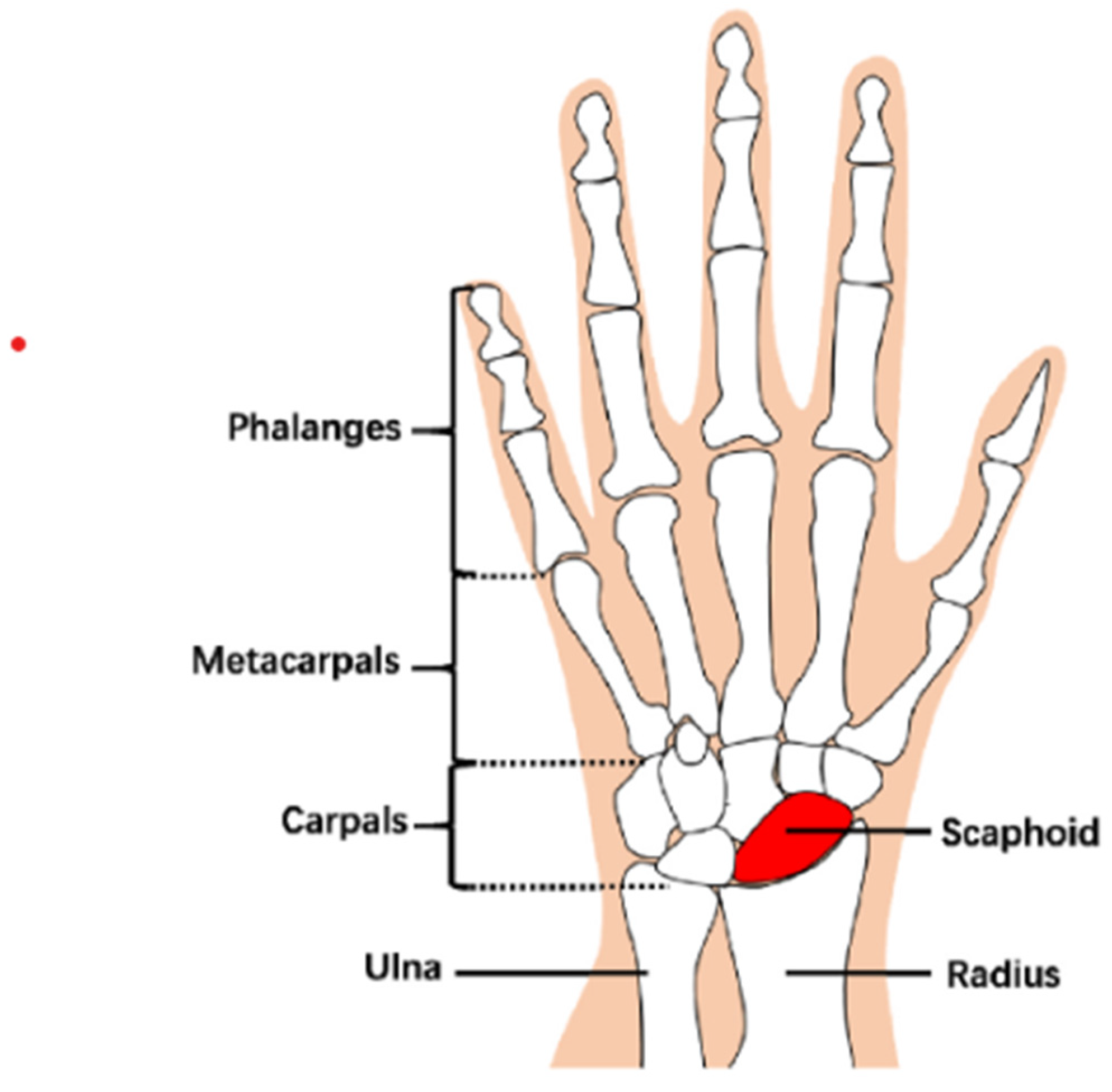
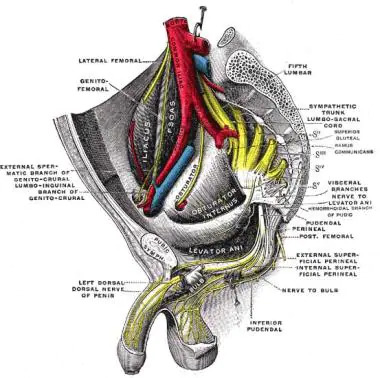

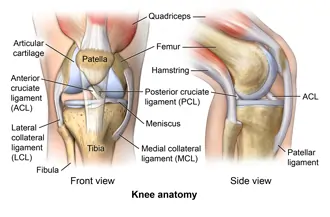
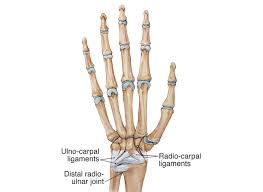
2 Comments